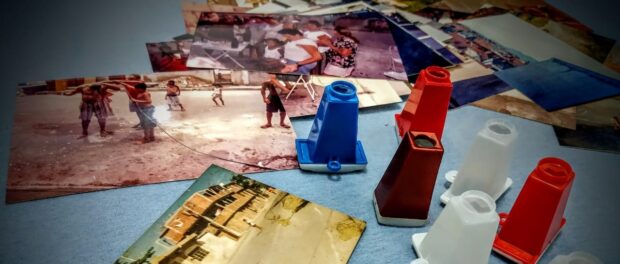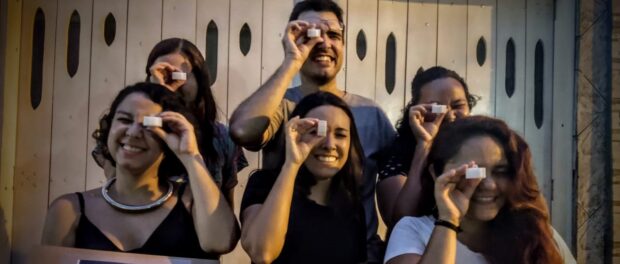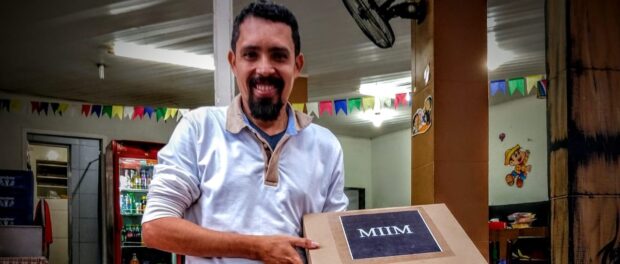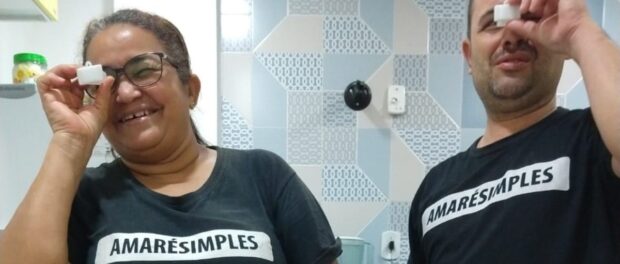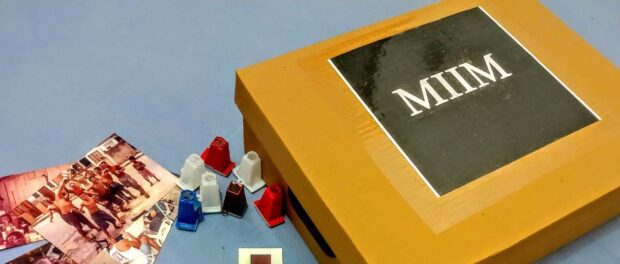
Complexo da Maré, a group of 16 favelas home to 140,000 residents in Rio de Janeiro’s North Zone, is now home to three incredible museums. The Maré Museum, inaugurated May 13, 2006 as a project of the Center for Studies and Solidarity Actions of Maré (CEASM), is the oldest and most traditional of the three, given its permanent physical structure. Maré’s second museum, the Maré a Céu Aberto (Maré Open-Air Museum), a project under development by Redes da Maré (Maré Development Networks NGO), is an experiential museum that takes visitors on a walking journey through the community. And finally, the Traveling Museum of Images, or MIIM, to use its Portuguese acronym, is Maré’s latest, inaugurated on August 18, 2019.
Maré resident Francisco Valdean, founder of the MIIM, launched the museum with a Facebook post, explaining that “the MIIM is a different kind of museum. It doesn’t have an address; it’s a traveling museum. More specifically, the museum is contained in a cardboard box the size of a shoebox.”
The unpretentious Facebook launch, along with the concept of housing the museum in a cardboard box, have caused some surprise. In an interview, Valdean joked about visitors’ reactions. “There are two kinds of reactions to the museum. There are people that say ‘Come on, you call that a museum?!’ and there are others that say ‘Wow! It’s a museum!’ Some people doubt that the MIIM is a museum and others are super impressed that, yes, this is a museum!”
Valdean wears many hats at the MIIM: he’s the museum’s creator, director, curator, and guide. He casually pulls the cardboard box out of a bag, removes the lid, and opens the museum. Inside there are three permanent exhibitions: Monoculars, Photographic Negatives, and Albums of Private Lives in Maré. Before “entering” the museum, visitors sign their names in a guest log, also kept inside the box. Valdean hopes to eventually cover three themes at the museum: culture, daily life, and the politics of images in Maré, covering the period from Maré’s origins in 1940 to present day. Valdean’s archive is not yet complete. For the Monocular (mini slide viewer) exhibit, he hopes to achieve a collection of 100 images. For the Private Lives exhibit, the idea is to have two parts: first, a series of 6×4 photos, and second, texts where he describes images that he hasn’t photographed, inviting visitors to create images that accompany the texts in their minds.
Though Valdean is still in the process of acquiring photos for the permanent exhibitions, other artists have already expressed interest in putting on temporary exhibitions at the MIIM, and Valdean has begun to put together a program.
Visitors can experience the museum sitting at a bar, at a barbecue, on their porch, or in a classroom at school, for example, all the while conversing with the museum’s guide-curator-director-creator. The museum’s archive includes old and new photos. Each mini slide viewer holds a surprise for the visitor. One such surprise is a photo of a group of students at the local Escola Municipal Bahia school, where Valdean studied and now works as a sociology teacher. Another slide viewer displays a photo of Marielle Franco holding a protest banner in support of the “Free our Sacred Objects” campaign. Valdean took the photo of Franco three months before the city councillor was assassinated. In another slide viewer we can see a group of women gathered at the Nova Holanda Residents Association, probably during the 1970s, as part of an all-female campaign to found the association. The photos bring visitors up close and personal with Maré’s streets, squares, events, and residents, as well as Valdean’s own personal life: his friends from school, his wife, and his father-in-law’s bar in the Maré favela of Vila do João.
At the end of the visit to the museum, Valdean puts the images back in the cardboard box and closes it. But the conversation continues once the box is closed, with visitors impressed by the simplicity of MIIM and the irony of its name. The acronym resembles the Portuguese word for “me,” reminding us that every Maré resident holds a museum within them—an archive of memories of Maré and the city of Rio de Janeiro.
“Museums today need to be re-thought, to reflect and reevaluate their purpose. A museum can’t just be a physical space, standing still waiting for visitors to come to it, which is the way we usually think of museums,” said Valdean. “Instead of waiting for visitors to come to them, museums could go to the people, go to schools, or to Family Health Clinics. MIIM is designed to go where people are, but at the same time it could motivate people to go to traditional museums as well.”
Although the ‘I’ in MIIM stands for itinerant, Valdean prefers to refer to the museum using the word ambulante, which is often used in the context of traveling street vendors. He explains that he has had lots of different jobs since he arrived in Rio from Ceará, a state in northeast Brazil, aged 15, including a three-year stint as a street vendor.
“When I arrived in Baixa do Sapateiro [one of Maré’s favelas] I was given the nickname ‘Para,’ because people assumed I was from Paraíba [a state in northeast Brazil, neighboring Ceará],” he says. “I used to say ‘I’m not from Paraíba, I’m from Ceará.’ Everyone in Rio thought that all northeasterners were from the same place. Then I realized that ‘Para’ was a kind of collective name and that there were dozens of ‘Paras’ from lots of different places in the Northeast. I realized that it was a term used by residents to say that you weren’t a local.”
Valdean remembers that life as a migrant wasn’t easy. In his case, it was photography that opened doors for him in Maré. “Migrants don’t walk freely across Maré, but I had my camera with me. It was rare to have a camera in those days and my group of friends would invite me out with them to take photos.”
Living in the 500-resident village of Cachoeira Grande, in Greater Rio, Valdean only completed his studies through third grade—that was the highest level of education available for Cachoeira residents at the time. But Valdean’s aunt lived in Nova Holanda and his mother lived in Baixa do Sapateiro, both favelas in Complexo da Maré. He went to live with his mother. Now he lives in Morro do Timbau in Maré with his wife Viviane and his daughter Luiza, and has now lived in Maré for 22 years. “Migrants always bring dreams with them on their journey, don’t they? My dream was to study a bit more and get to finish high school,” says Valdean.
Balancing his studies and his work, Valdean managed to finish grade school via a supplementary course and, in 2003, began high school at Escola Bahia. The following year, he enrolled in a professional photography course at the School of Popular Photographers run by the Favelas Observatory NGO, located in Nova Holanda. Having completed high school and the photography course just as social inclusion policies were being promoted more widely in Rio, Valdean was able to study Social Sciences at Rio de Janeiro’s State University, UERJ. He then obtained a Masters Degree in Visual Anthropology and is currently midway through a Ph.D. in Arts. As part of his Ph.D., Valdean has been working on photos from the favelas of Maré.
The idea to create MIIM was the result of Valdean’s experience as a photographer in Maré, along with his academic and artistic training. In 2018, while in artistic residency at the State University of Minas Gerais (UFMG), Valdean discovered the Fiotim Museum, a project created by the artist Jorge Fonseca. The Fiotim Museum fit inside a car and the name was a play on words based on the famous Inhotim Museum. Another important influence for Valdean was the 2015 Interiores da Maré (Maré Interiors) exhibition by artists Henrique Gomes from Brazil and Antonello Veneri from Italy, held at the Galpão Bela Maré arts center. The exhibition consisted of photos of Maré residents in their houses. The photos were printed on panels, some of which were displayed inside the arts center while others were displayed on the street outside. Valdean helped Henrique take down the photos after the exhibition and deliver them to the residents who were photographed. He remembered that in one of the houses, a married couple was upset, thinking that their photo had been left out on the street. Gomes defended his project, saying that the exhibition as agreed upon involved placing certain photos inside the arts center and others on the street.
“When the photo of the couple was displayed outside on the street, everyone who saw it was worried and went to the couple’s house to see if something bad had happened. I thought to myself ‘that’s what I’m looking for,’” said Valdean. “In the eyes of Maré residents, the fact that the photo of the couple was displayed outside on the street could only mean violence. But neither the photo of the couple nor the exhibition as a whole had anything to do with violence. It was just that for people living in Maré, a photo outside had to mean violence: there was no other possible explanation [as to why someone’s photo would be displayed in the street]. That was the moment that my research took another direction. I started to think about how the city of Rio imagines Maré and how Maré imagines itself. Maré is also impacted by the images of the community that are shared by the media. Regarding this symbolic field of images, focusing on this issue, I wanted to create a tool by which I could understand how Maré imagines itself. And it was in these last few months that I had the idea to create this museum.”
For his master’s thesis, entitled “Imagens da Maré: narrativas fotográficas de um território favelado” (Images of Maré: photographic narratives of a favela territory), Valdean identified three archetypal images of Maré produced by mainstream media: images of violence, images of removals, and images of historic Maré’s stilt-supported houses.
“My interpretation is that photojournalism shows Maré from a specific point of view. It follows State actions: evictions are done by the State, which garners media interest. There was a lot of coverage of Maré’s stilt houses in 1979 when the Project Rio urban renewal program was underway—this was also a project undertaken by the State that got a lot of media coverage. When it comes to violence, photographs show the actions of the State too. Nobody seems to be interested in photos showing the point of view of Maré residents, different from what we do at the Imagens do Povo (Images of the People) photography project.” Along with fellow photographer and Maré resident Bira Carvalho, Valdean is one of the coordinators of the Imagens do Povo photo archive.
On beginning his Ph.D. in Arts, Valdean proposed researching photos created by Maré residents who had not been trained in photography. For Valdean, “This turned into the idea to create the museum.”
Although the idea of turning a simple cardboard box into a museum causes some surprise and can seem like a joke, visitors quickly recognize the complexity and creativity of the concept: the museum provokes reflection not only on the production of images regarding and inside the favela, but also on the equipment and tools employed in their preservation and dissemination.
Valdean, who teaches sociology at two schools in Maré, talks about the different reactions from his students, many of whom have never been to a traditional museum but who have visited the MIIM, as well as friends, neighbors, and locals at his father-in-law’s bar in Vila do João. Since launching the museum on August 18, Maré’s newest museum is already scheduling visits. Interested visitors can book by contacting Valdean through MIIM’s Facebook page, here.
Miriane Peregrino is a researcher, community journalist, and teacher with a Master’s Degree in literature from the State University of Rio de Janeiro (UERJ). In 2013, she created the Literatura Comunica! (“Literature Speaks!”) literacy project, which is active in schools, community libraries, and cultural centers. Born in the interior of Rio state, she has worked in Maré since 2013.

